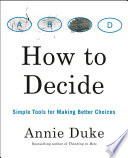

The book emphasizes the importance of structured decision-making frameworks. It introduces various models that help in breaking down complex decisions into manageable parts. By employing frameworks such as cost-benefit analysis, decision trees, and the Eisenhower matrix, individuals can gain clarity on their choices. The author illustrates how these frameworks can help prioritize options based on their potential outcomes, risks, and benefits. This systematic approach not only reduces cognitive overload but also fosters more informed and rational decisions.
Continue readingOne of the central themes of the book is the acceptance of uncertainty in decision-making. The author argues that many people avoid making decisions due to fear of failure or the unknown. Instead, the book encourages readers to embrace uncertainty as a natural part of life. By understanding and quantifying risks, individuals can make more confident decisions. The author provides strategies for assessing potential risks and rewards, emphasizing that taking calculated risks can lead to greater opportunities and growth.
Continue readingThe book explores the intricate relationship between emotions and decision-making. It highlights how emotions can both positively and negatively influence choices. The author discusses the concept of emotional intelligence and its importance in recognizing and managing one's feelings during the decision-making process. By being aware of emotional biases, individuals can mitigate their impact and make more objective decisions. The book also provides techniques for harnessing positive emotions to enhance decision-making outcomes.
Continue readingEffective decision-making relies heavily on the quality of information available. The author stresses the importance of gathering relevant data and insights before making a decision. This includes conducting thorough research, seeking expert opinions, and analyzing past experiences. The book offers practical tips on how to filter out noise and focus on crucial information that can guide decisions. By emphasizing the need for a well-informed approach, the author empowers readers to make decisions based on facts rather than assumptions.
Continue readingCollaboration is presented as a vital component of effective decision-making. The author argues that involving others in the decision-making process can lead to better outcomes. By seeking feedback from diverse perspectives, individuals can uncover blind spots and gain new insights. The book discusses techniques for fostering a collaborative environment, such as brainstorming sessions and structured discussions. It also highlights the value of constructive feedback in refining decisions and ensuring that all voices are heard.
Continue readingMaking a decision is only part of the process; implementing that decision effectively is equally important. The book outlines strategies for executing decisions and monitoring their outcomes. The author emphasizes the need for adaptability and flexibility, as circumstances may change after a decision is made. Additionally, the book encourages a mindset of continuous learning, where individuals reflect on their decisions and outcomes to improve future decision-making. This iterative approach fosters growth and resilience.
Continue readingLastly, the book advocates for cultivating a proactive decision-making mindset. This involves developing habits and attitudes that support effective decision-making. The author suggests practices such as mindfulness, self-reflection, and goal-setting to enhance one's decision-making abilities. By fostering a growth-oriented mindset, individuals can become more comfortable with making decisions and navigating uncertainty. The book concludes with actionable steps to integrate these practices into daily life, empowering readers to take charge of their decision-making journey.
Continue reading